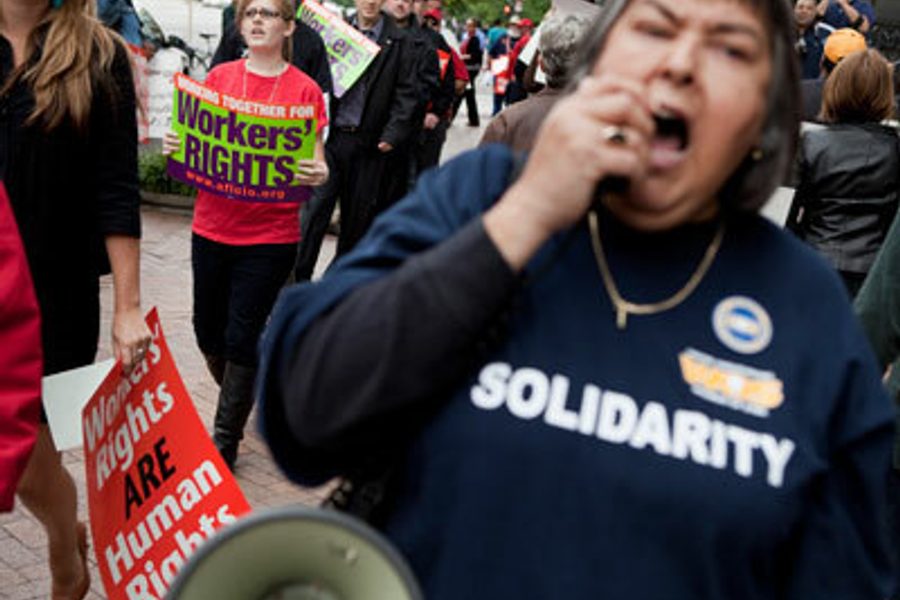
A subsidiary of Grupo Mexico says it has retaken the Cananea copper mine after several hundred federal police used tear gas on June 6 to evict union miners on strike for almost three years.
The company announced production at the world’s largest deposit of copper would be at “normal” levels by next year. The open pit mine has been intermittently closed and operating at a low level since the National Revolutionary Mine and Metal Workers Union of Mexico went on strike in July 2007, demanding that extremely dangerous and unhealthy working conditions be rectified. Strikers have constantly stood guard at mine entrances, and the strike has bitterly divided the town and sparked violence between neighbors and even families.
Before dawn on Monday June 7, state police and Grupo Mexico employees also rousted families from the Pasta de Conchos Grupo Mexico mine in Sonora state who have been searching – in symbolic protest – for the bodies of 65 miners buried during an explosion in February 2006. Grupo Mexico has said it plans to restart mining there, despite a government-ordered freeze on operations.
These are serious blows in a larger battle over the future of independent unionism in Mexico.
Union leaders have said they expected police action during the World Cup, when most of the country would be fixated on soccer. But the actions came even before the World Cup kick-off. Government officials have said the police at Cananea were unarmed. Union members say the police were accompanied by paramilitaries, and three people were injured during the raid.
Cananea is known as a cradle of the Mexican Revolution, and in recent years it has been a symbol of the larger power struggle between unions and the conservative PAN government and multi-national companies. Miners and other workers across the country have gone on strike in solidarity with Cananea and miners at several other Grupo Mexico mines.
The threat of federal police action had loomed over Cananea since a February federal court decision ruling the strike illegal on the grounds that the mine had become inoperable due to sabotage and neglect (read my March 2010 blog here).
Union miners dispute the idea that they are to blame for sabotaging the mine or allowing it to deteriorate. They allege that before the strike, the company had let conditions inside the mine deteriorate to dangerous extremes perhaps in a bid to force workers to quit or to push worker action that might help the company break the union. International delegations of doctors and labor organizers in April and October 2007 documented numerous serious safety violations in the mine, as Jessica Pupovac and I described for In These Times.
Grupo Mexico has said it will take $220 million to repair and reopen the mine, and 2,000 people will be hired. They won’t be covered by the collective bargaining agreement with the Mine and Metal Workers Union, which federal courts this year ruled terminated. Copper prices had soared to record highs shortly before the strike, then plummeted during the economic crisis and chill in construction worldwide. Experts expect copper prices to climb again as the economy recovers. Grupo Mexico has announced it will invest $3.8 billion in Cananea to double copper production from current levels.
AFL-CIO President Richard Trumka, from a mining family himself, said the U.S. government should suspend its multi-billion-dollar Plan Merida aid initiative in light of the police action.
Sunday night’s assault is yet another example of the Mexican government’s unjustified persecution of miners who are bravely taking a stand against the country’s largest mining company, Grupo Mexico. U.S. support to Mexican security forces is enabling the Mexican government and Grupo Mexico to violate workers’ most basic rights. As long as the Mexican military and police continue to violate the fundamental rights of workers, the U.S. Congress should freeze current funding for these forces and any proposals for future support.
Increasing metal prices are likely to ratchet up tensions in labor struggles at mines worldwide. The United Steel Workers of America have formed a close alliance with the Cananea miners, with steel workers visiting Cananea in February for a forum held in response to the federal court decision. The international show of solidarity was in part an effort to hold off violence from federal authorities.
During that visit, steel worker Jim Robinson said:
Our unions are very similar. As in Mexico, the Steelworkers are miners of copper, gold, silver, and iron. As in Mexico, the Steelworkers are workers in steel plants and foundries. And as in Mexico, the Steelworkers know that the struggle in Mexico is not only about the workers of Mexico but it is a struggle of all the workers of the world.
We know that the working and living conditions of one group of workers affects the conditions of others. The struggle of the Mineros against Grupo Mexico in Cananea affects the struggle of Steelworkers against Grupo Mexico in Arizona. And things are the same for workers at American Steel Foundries in Sahagun, Mexico, and Granite City, U.S.; at ArcelorMittal in Lazaro Cardenas, Mexico, and Indiana Harbor, U.S.; and at Dana in Mexico and the U.S. The Mineros and the Steelworkers know equally well that the injury to one is an injury to all.
Kari Lydersen is a Chicago-based journalist, author and assistant professor at Northwestern University, where she leads the investigative specialization at the Medill School of Journalism, Media, Integrated Marketing Communications. Her books include Mayor 1%: Rahm Emanuel and the Rise of Chicago’s 99%.








